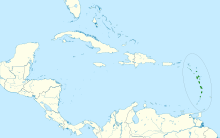Purple throated hummingbird
| Purple throated hummingbird | ||||||||||
|---|---|---|---|---|---|---|---|---|---|---|

Purple throated hummingbird |
||||||||||
| Systematics | ||||||||||
|
||||||||||
| Scientific name | ||||||||||
| Eulampis jugularis | ||||||||||
| ( Linnaeus , 1766) |
The purple-throated Hummingbird ( Eulampis jugular ) is a species of bird in the family of hummingbirds (Trochilidae). Its distribution area includes parts of the Lesser Antilles . The IUCN assesses the population as Least Concern .
features
The purple-throated hummingbird reaches a body length of about 9 to 12 cm, with a weight of 9 to 12 g for males and 7 to 10 g for females. The male's black, slightly recovered beak is relatively short. It is a strong dark velvet colored hummingbird. The cheek area, throat and chest are fiery purple-red. The lower tail and the upper tail covers have a metallic green-blue sheen. The wings glow golden green. Females are similar to males but have a longer and more curved beak. In immature purple-throated hummingbirds, the throat and chest are orange with red spots.
Behavior and nutrition
The birds get their nectar from native plants such as cordias or the genus Clusia, which belongs to the family Clusiaceae, as well as from imported trees such as the African tulip tree , the genus Delonix , which belongs to the carob family, or Caesalpinien . They collect from the middle strata at heights between two and three meters up to the treetops. Occasionally they fly to the flowers of Heliconia caribea and bananas . They also hunt insects in flight, but it is much more common for them to peck arthropods from leaves or spider webs. The males keep a feeding area with many flowers all year round . The females only show this territorial behavior outside of the breeding season.
Vocalizations
The singing includes a loud tsip and a sharp chep , which the hummingbirds quickly repeat when they are concerned.
distribution and habitat
Purple-throated hummingbirds live in the treetops at the edges of secondary and primary forests at altitudes between 800 and 1200 meters.
Reproduction
The breeding season lasts from February to May, and occasionally from January to September. The robust, goblet-like nest is made by purple-throated hummingbirds in vertical branches in trees three to five meters above the ground. It looks relatively small compared to the size of the birds. When building, they use soft plant fibers and cobwebs. Occasionally they camouflage them with strips of bark, moss and lichen, material that they attach to the outer wall of the nest. The clutch consists of two eggs and is hatched by the female. An egg is 15 to 16.2 by 10.4 to 10.6 mm in size. The breeding season varies between 17 and 19 days. The chicks are dark. The nestlings fledge at around 17 to 20 days, but the young stay with their mother for another 2 to 3 weeks. The female is extremely territorial around the nest and attacks even larger species when they get up to 10 meters near the nest.
migration
On some islands such as St. Lucia and St. Vincent , individual purple-throated hummingbirds occur at high altitudes around sea level in late May. You only see them by chance on Barbuda , La Désirade , Îles des Saintes and Bequia . There are few reports from Grenada and Barbados . Very seldom you see them as a stray visitor in the Greater Antilles .
Subspecies
The species is considered to be monotypical .
Etymology and history of research
Originally, Carl von Linné described the purple-throated hummingbird under the name Trochilus jugularis . He erroneously stated Cayenne and Suriname as the collection point . In 1831 Friedrich Boie introduced the new generic name Eulampis . This name is made up of the Greek words "eu ευ " for "beautiful" and "lampēs λαμπης " for "sun". »Jugularis« is derived from the Latin »iugulum« for »throat«.
literature
- Karl-Ludwig Schuchmann , Peter Boesman in: Josep del Hoyo , Andrew Elliott, Jordi Sargatal , David Andrew Christie , Eduardo de Juana: Purple-throated Carib (Eulampis jugularis) in Handbook of the Birds of the World Alive . Lynx Edicions, Barcelona.
- James A. Jobling: Helm Dictionary of Scientific Bird Names . Christopher Helm, London 2010, ISBN 978-1-4081-2501-4 .
- Carl von Linné: Systema Naturae per Regna Tria Naturae, Secundum Classes, Ordines, Genera, Species, Cum Characteribus, Differentiis, Synonymis, Locis . 12th edition. tape 1 . Imprensis Direct Laurentii Salvii, Stockholm 1766 ( biodiversitylibrary.org ).
- Friedrich Boie: Comments on species and some ornithological families and clans . In: Isis von Oken . tape 24 , 1831, pp. 538-548 ( biodiversitylibrary.org ).
Web links
- Eulampis jugularis inthe IUCN Red List of Threatened Species 2017.3. Listed by: BirdLife International, 2016. Retrieved May 1, 2018.
- BirdLife International: Species Factsheet - Purple-throated Carib ( Eulampis jugularis ) . Retrieved May 1, 2018.
- Videos, photos and sound recordings of Purple-throated Carib (Eulampis jugularis) in the Internet Bird Collection
- Purple-throated hummingbird ( Eulampis jugularis ) at Avibase; accessed on May 1, 2018.
- Eulampis jugularis in the Integrated Taxonomic Information System (ITIS). Retrieved on 2018-05-01.
- xeno-canto: Sound recordings - Purple-throated Carib ( Eulampis jugularis )
- Purple-throated Hummingbird (Eulampis jugular) in the Encyclopedia of Life . Retrieved May 1, 2018.
Individual evidence
Remarks
- ↑ Boie assigned the purple- throated hummingbird (Syn: Trochilus violaceus Gmelin, JF 1788, Trochilus auratus Gmelin, JF 1788) and the black hummingbirds ( Florisuga fusca ( Vieillot , 1817)) (Syn: Trochilus niger Wied , 1832) to the genus .
